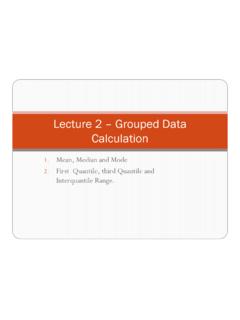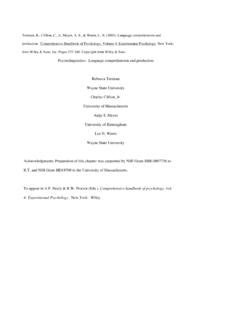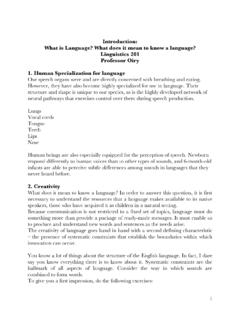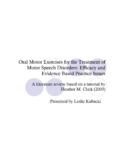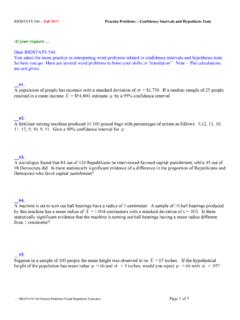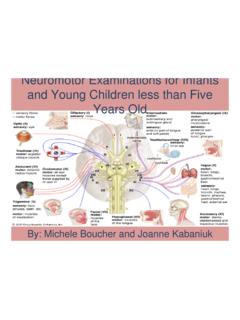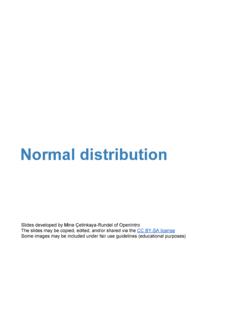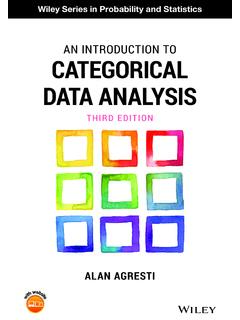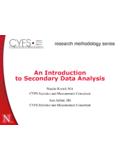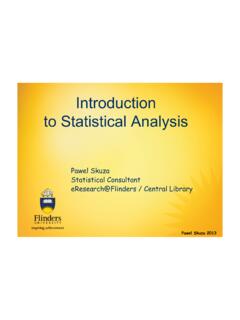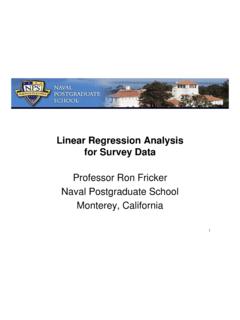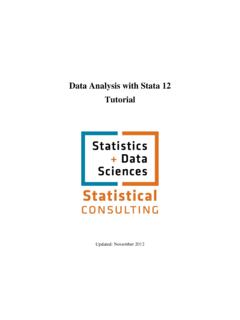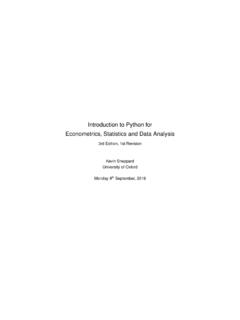Transcription of Unit 4 Categorical Data Analysis - UMass Amherst
1 BIOSTATS 640 - Spring 2020 4. Categorical data Analysis - R Users Page 1 of 78 Nature Population/ Sample Observation/ data Relationships/ Modeling Analysis / Synthesis Unit 4 Categorical data Analysis Don t ask what it means, but rather how it is used - L. Wittgenstein Is frequency of exercise associated with better health? Is the proportion of adults who visit their doctor more than once a year, significantly lower among the frequent exercisers than among the non-exercisers? Is alcohol associated with higher risk of lung cancer? Is the apparent association misleading because we have failed to account for the relationship between drinking and smoking?
2 Is greater exposure to asbestos associated with the development of pleural plaques? Is more exposure associated with more pleural plaques? Units 2 (Discrete Distributions) and 4 ( Categorical data Analysis ) pertain to questions such as these and are an introduction to the Analysis of count data that can be represented in a contingency table (a two-way cross-tabulation of the counts of individuals with each profile of traits; eg non-drinker and lung cancer). data that are counts are Categorical data . A Categorical variable is measured on a scale that is nominal (eg religion) or ordinal (eg diagnosis coded as benign , suspicious , or malignant ). Unit 4 ( Categorical data Analysis ) is an introduction to some basic methods for the Analysis of Categorical data : (1) association in a 2x2 table; (2) variation of a 2x2 table association, depending on the level of another variable; and (3) trend in outcome in a contingency table.
3 Nice .. These methods require minimal assumptions for their validity and, in particular, do not assume a regression model. These methods, in contrast to regression approaches, have the added advantage of giving us a much closer look at the data than is generally afforded by regression techniques. Tip always precede a logistic regression Analysis with contingency table analyses. BIOSTATS 640 - Spring 2020 4. Categorical data Analysis - R Users Page 2 of 78 Nature Population/ Sample Observation/ data Relationships/ Modeling Analysis / Synthesis Table of Contents Topics 1. Learning Objectives.
4 2. Examples of Categorical data .. 3. Hypotheses of Independence, No Association, Homogeneity .. 4. The Chi Square Test of No Association in an RxC Table .. 5. Rejection of Independence: The Chi Square 6. Confidence Interval Estimation of RR and OR .. 7. Strategies for Controlling Confounding .. 8. Multiple 2x2 Tables - Stratified Analysis of Rates .. A. Woolf Test of Homogeneity of Odds B. Breslow-Day-Tarone Test of Homogeneity of Odds Ratios .. C. How to estimate the Mantel-Haenszel Odds Ratio .. D. Mantel Haenszel Test of No Association .. 9. The R x C Table Test for (Linear) Trend .. 10. The Chi Square Goodness-of-Fit Test .. 3 4 9 10 16 20 24 26 31 33 36 37 40 46 Appendices A.
5 The Chi Square Distribution .. B. Probability Models for the 2x2 Table .. C. Concepts of Observed and Expected .. D. Review: Measures of Association in a 2x2 Table .. E. Review: Confounding of Rates .. 55 59 61 65 71 BIOSTATS 640 - Spring 2020 4. Categorical data Analysis - R Users Page 3 of 78 Nature Population/ Sample Observation/ data Relationships/ Modeling Analysis / Synthesis Learning Objectives When you have finished this unit, you should be able to: Perform and interpret the chi square test of association in a single 2x2 table. Define and distinguish between exposure-outcome associations that are confounded versus effect modified.
6 Perform and interpret an Analysis of stratified 2x2 tables, using Mantel-Haenszel methods. Perform and interpret the test of trend for RxC tables of counts of ordinal data that are suitable for explorations of dose-response. Perform and interpret a chi square goodness-of-fit (GOF) test. Note - Currently, this unit does not discuss matched pairs or matched data . BIOSTATS 640 - Spring 2020 4. Categorical data Analysis - R Users Page 4 of 78 Nature Population/ Sample Observation/ data Relationships/ Modeling Analysis / Synthesis 2. Examples of Categorical data Source: Fisher LD and Van Belle G.
7 Biostatistics: A Methodology for the Health Sciences New York: John Wiley, 1993, page 235, problem #14. Is there a relationship between coffee consumption and cardiovascular risk? What about the observation that many coffee drinkers are also smokers and smoking is itself a risk factor for heart disease? Suppose we wish to estimate the nature and strength of a coffee-MI relationship independent of the role of smoking. We can do this by looking at coffee-heart disease data separately within groups (strata) defined by separate levels of the 3rd variable smoking. Consider the following bar graph summaries that compare low coffee drinkers (left bar) with high coffee drinkers (right bar) with respect to proportion suffering a myocardial infarction (MI).
8 The comparison is made for each of several categories of smokers (each row). Never Smoked Former Smoker .. Some rows omitted 45+ cigarettes/day Stratum=never smokers: Among never smokers, the data suggest a positive coffee-MI relationship. Stratum=former smokers: Among former smokers, the coffee-MI association is less strong. Stratum=45+cigarettes/day: Among frequent smokers, there is no longer evidence of a coffee-MI association. We have an interaction! The association of coffee consumption with myocardial infarction (MI) is different (modified by), depending on smoking status. Proportion MICoffee micase0=lt 5 cups/day1=ge 5 cups/dayProportion MICoffee micase0=lt 5 cups/day1=ge 5 cups/dayProportion MICoffee micase0=lt 5 cups/day1=ge 5 cups/dayBIOSTATS 640 - Spring 2020 4.
9 Categorical data Analysis - R Users Page 5 of 78 Nature Population/ Sample Observation/ data Relationships/ Modeling Analysis / Synthesis In Unit 2 (Discrete Distributions) we learned some probability distributions for discrete data : Binomial, Poisson, and Hypergeometric. These probability distributions are often used to model the chances of ( likelihood which we abbreviate as L ) obtaining the observations that we have in our data . Here are some examples. Example - Binomial for One Group Count of Events of Success Does minoxidil show promise for the treatment of hair loss? n=13 volunteers Administer minoxidil Wait 6 months Count occurrences of new hair growth.
10 Call this X. Suppose we observe X=12. Possible values of X=count of occurrences of new hair growth are 0, 1, 2, .., 13. Thus, IF: (1) = probability[new hair growth] for all 13 volunteers, and the (2) outcomes for each of the 13 volunteers are independent THEN: X is distributed Binomial (n=13, ) The likelihood ( chances of ) L of the outcomes in the one group intervention study design data is modeled as a binomial probability: Example - The probability of X=12 events of new hair growth in N=13 trials ( study participants ) = ()13-xxX13L (x) = Pr[X=x] = 1 - x ()11213 1- 12 BIOSTATS 640 - Spring 2020 4.
